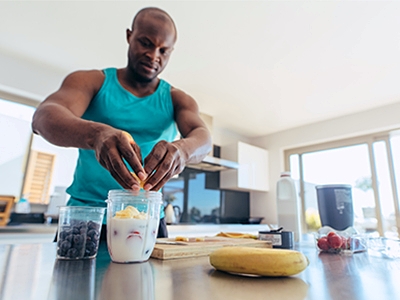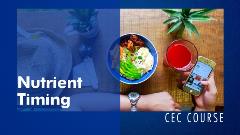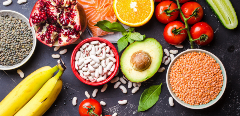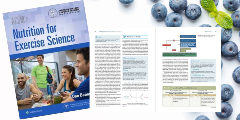Amy Goodson, MS, RD, CSSD, LD |
Nov.
6, 2019

3 Key Points
1. Milk, white and chocolate, is a nutrient-rich, affordable way to refuel and rehydrate after exercise for fitness enthusiasts or professional athletes.
2. Supplementing with 30-60 grams a day of dairy protein can help exercisers of all types improve muscle strength, aerobic fitness and body composition.
3. Dairy foods offer a variety of other nutrients and health benefits beyond exercise recovery. The complete nutrient package should be considered as a high-quality way to fuel and refuel on training and non-training days.

When most people think of dairy foods, they think of building strong bones. However, there are many nutrients in dairy foods that help support exercise recovery such as high quality protein for muscle repair and rebuilding, carbohydrate (in the form of lactose) for replenishment of glycogen stores, and fluids and electrolytes for restoring hydration (1). Plus, current research suggests that dairy foods (like milk and yogurt), as well as dairy protein ingredients (like casein and whey) can help improve body composition (2-6), strength (2, 4), aerobic fitness (5, 7) and exercise performance (8-10).

Check out three surprising benefits of dairy foods when it comes to refueling and rehydrating after a workout!
#1: Rehydration After A Workout
Nutrition and rehydration after exercise can help with recovery and may improve future exercise performance (1). Both milk and chocolate milk have been shown to help with muscle recovery after a workout, but some research suggests that milk may also be better for rehydration when compared to a carbohydrate and electrolyte beverage alone (11, 12).
A small study in the British Journal of Nutrition (11) investigated if drinking milk after a bout of dehydrating exercise would help restore fluid balance more than other beverages. The researchers found that, likely due to the nutrient package it provides, drinking milk did restore fluid balance better than water or a carbohydrate electrolyte beverage. The researchers suggested this may be due to the differences in how the three beverages are digested. Milk is released more slowly from the stomach compared to water or a traditional sports drink comprised of carbohydrates and electrolytes. The higher calorie content and presence of dairy proteins in milk are suggested as the main contributors of this effect. These findings support previous studies performed in adults and children (12) which are summarized in the handout found here.
Milk has other benefits when it comes to rehydration. Milk is a source of potassium (8% DV in each cup) and provides about 100 mg of sodium per 8-ounce glass, both electrolytes lost in sweat that need to be replaced after a workout.
Put it into action:
Milk and chocolate milk are convenient, affordable options for kids and adults. Found in almost every grocery store, school cafeteria and quick service restaurants, milk is a one stop shop providing carbohydrates to refuel, high quality protein to rebuild/repair muscle and fluids/electrolytes to help rehydrate after a workout. Milk can also be used as the base in fruit smoothies as a refreshing way to enjoy carbohydrates, protein and electrolytes.
#2: Improve Body Composition and Aerobic Fitness
When most exercisers and athletes think of adding protein to their diets, they typically associate the benefits in the context of resistance exercise training. Very few studies to date have investigated/demonstrated a benefit with endurance exercise. However, a 2019 study (13) took young, moderately active men and put them on a 10-week endurance training program. What is important to note is that this was not an elite athlete training program, but instead consisted of a routine most individuals can follow: 3 days a week of cycling for 60 minutes each day.
In addition to their regular diet, study participants consumed about 30 grams of dairy protein (casein) every day before sleep on non-training days. On training days, study participants consumed an additional 30 grams of dairy protein (casein) immediately following exercise as well as the 30 grams consumed before sleep (about 60 grams total in addition to their regular diet). Control study participants consumed a calorie matched carbohydrate replacement on all days in addition to their regular diet. After the 10 weeks, the group consuming more dairy protein (casein)had enhanced improvements in aerobic fitness (as measured by maximal oxygen consumption or VO2 max) and body composition (as measured by an increase in lean body mass and reduction in fat mass) compared to the control (carbohydrate) group.
While the role of higher protein diets can often be overlooked by endurance athletes and exercisers, this study suggests that a higher protein diet, with supplementation from dairy protein (casein), may be warranted for certain physiological improvements which can be seen with realistic exercise routines/programs. In this study the amount of protein consumed by study participants in the protein supplement group averaged out to 1.8 grams per kg body weight per day which falls within the range (1.2-2.0 grams per kg body weight per day) set forth by the Joint Position Statement of the Academy of Nutrition and Dietetics, Dietitians of Canada and ACSM on nutrition and athletic performance (1) and can be a realistic quantity to consume for those participating in endurance type fitness activities from running groups to marathons.
Put it into action:
What does 1.8 grams per kg body weight look like in food spread out in a day? For someone 150 pounds that means about 30 grams per meal and 15 grams per snack (if you are having two snacks/day). Sound like a lot? One cup of milk has 8 grams of protein, 1 oz of cheese, depending on type, can have between 6 and 8 grams of protein. A container (170 grams) of Greek yogurt has 15 grams of protein. Having quick and easy protein-rich snacks and post-workout snacks available can help people reach their protein goal. Snacks like smoothies made with dairy protein, Greek yogurt mixed with fruit and granola or yogurt mixed with chia seeds for an overnight protein-rich pudding are ways to fuel and refuel on the go.
#3: It’s Not Just About Milk
We know that milk and/or whey protein plus resistance exercise can increase strength and muscle size and optimize body composition in adult males and females. But do other dairy foods have the same effect?
Greek yogurt contains similar muscle-supporting nutrients as milk yet differs by being a semi-solid food, containing bacterial cultures and having a higher protein content (mostly casein) per serving. While it had previously not been investigated, a 2019 (4) 12-week study showed that supplementing a 3-day a week plyometric strength training program with Greek yogurt resulted in improved strength, muscle thickness and body composition when compared to a carbohydrate-based placebo. Study participants consumed Greek yogurt (20 grams protein per serving) three times a day on training days and two times a day on non-training days.
The results of the study indicate that Greek yogurt can be a plausible, nutrient-rich way to refuel post-exercise.
Put it into action:
There are many ways Greek yogurt can be consumed. Smoothies and overnight oats and pudding recipes are always great options, but Greek yogurt can also be used as a base for dips to pair with fruit and veggies, as well as for sauces on wraps, pizzas or in pastas.
Author:

Amy Goodson, MS, RD, CSSD, LD is a dietitian and Certified Specialist in Sports Dietetics. Amy has worked with the Dallas Cowboys, Texas Rangers, TCU Athletics, Ben Hogan Sports Medicine, Dairy Farmers of America and more. She is a co-author of Swim, Bike, Run, Eat and nutrition contributor to retired NFL Player Donald Driver’s book, The 3-D Body Revolution. She is a writer for Women’s Running Magazine and owner of RD Career Jumpstart. Amy is an ambassador for the American Heart Association and National Dairy Council, a speaker/consultant for Gatorade Sports Science Institute and a media dietitian for RDTV.
References:
- Med Sci Sports Exerc. 2016;48(3):543-68.
- Med Sci Sports Exerc. 2010;42(6):1122-30.
- Am J Clin Nutr. 2007;86(2):373-81.
- Front Nutr. 2019;6:55.
- J Nutr Metab. 2011;2011:623182.
- J Am Coll Nutr. 2013;32(2):122-35.
- Am J Clin Nutr. 2019;110( 2):508–518.
- Med Sci Sports Exerc. 2012;44(4):682-91.
- J Strength Cond Res. 2011;25(5):1210-24.
- J Int Soc Sports Nutr. 2019;16(1):6.
- Br J Nutr. 2016;116(6):1013-21.
- Appl Physiol Nutr Metab. 2014;39(11):1257-64.
- Am J Clin Nutr. 2019;110(2):508-18.
Read More Popular Nutrition Content

Free Sample Download - ACSM's Nutrition for Exercise Science

Nutrient Timing | CEC Course

Sports Nutrition Myths Busted

10 Things You Need to Know About Sports Nutrition